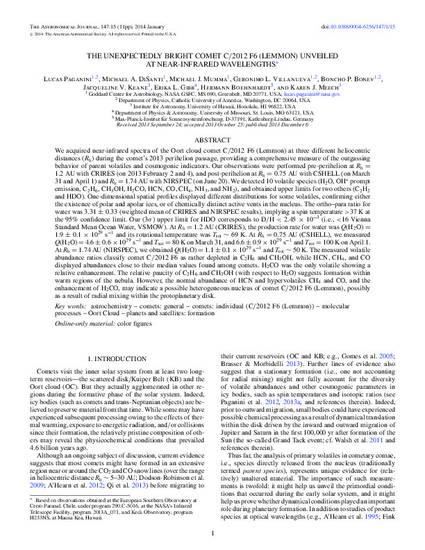
Article
The Unexpectedly Bright Comet C/2012 F6 (Lemmon) Unveiled at Near-Infrared Wavelengths
The Astronomical Journal
(2013)
Abstract
We acquired near-infrared spectra of the Oort cloud comet C/2012 F6 (Lemmon) at three different heliocentric distances (R h) during the comet's 2013 perihelion passage, providing a comprehensive measure of the outgassing behavior of parent volatiles and cosmogonic indicators. Our observations were performed pre-perihelion at R h = 1.2 AU with CRIRES (on 2013 February 2 and 4), and post-perihelion at R h = 0.75 AU with CSHELL (on March 31 and April 1) and R h = 1.74 AU with NIRSPEC (on June 20). We detected 10 volatile species (H2O, OH* prompt emission, C2H6, CH3OH, H2CO, HCN, CO, CH4, NH3, and NH2), and obtained upper limits for two others (C2H2 and HDO). One-dimensional spatial profiles displayed different distributions for some volatiles, confirming either the existence of polar and apolar ices, or of chemically distinct active vents in the nucleus. The ortho-para ratio for water was 3.31 ± 0.33 (weighted mean of CRIRES and NIRSPEC results), implying a spin temperature >37 K at the 95% confidence limit. Our (3σ) upper limit for HDO corresponds to D/H < 2.45 × 10–3 (i.e., <16 Vienna Standard Mean Ocean Water, VSMOW). At R h = 1.2 AU (CRIRES), the production rate for water was Q(H2O) = 1.9 ± 0.1 × 1029 s–1 and its rotational temperature was T rot ~ 69 K. At R h = 0.75 AU (CSHELL), we measured Q(H2O) = 4.6 ± 0.6 × 1029 s–1 and T rot = 80 K on March 31, and 6.6 ± 0.9 × 1029 s–1 and T rot = 100 K on April 1. At R h = 1.74 AU (NIRSPEC), we obtained Q(H2O) = 1.1 ± 0.1 × 1029 s–1 and T rot ~ 50 K. The measured volatile abundance ratios classify comet C/2012 F6 as rather depleted in C2H6 and CH3OH, while HCN, CH4, and CO displayed abundances close to their median values found among comets. H2CO was the only volatile showing a relative enhancement. The relative paucity of C2H6 and CH3OH (with respect to H2O) suggests formation within warm regions of the nebula. However, the normal abundance of HCN and hypervolatiles CH4 and CO, and the enhancement of H2CO, may indicate a possible heterogeneous nucleus of comet C/2012 F6 (Lemmon), possibly as a result of radial mixing within the protoplanetary disk.
Disciplines
Publication Date
December 6, 2013
DOI
10.1088/0004-6256/147/1/15
Citation Information
Lucas Paganini, Michael A. Disanti, Michael J. Mumma, Geronimo L. Villanueva, et al.. "The Unexpectedly Bright Comet C/2012 F6 (Lemmon) Unveiled at Near-Infrared Wavelengths" The Astronomical Journal Vol. 147 Iss. 1 (2013) p. 15 - 25 Available at: http://works.bepress.com/erika-gibb/13/
